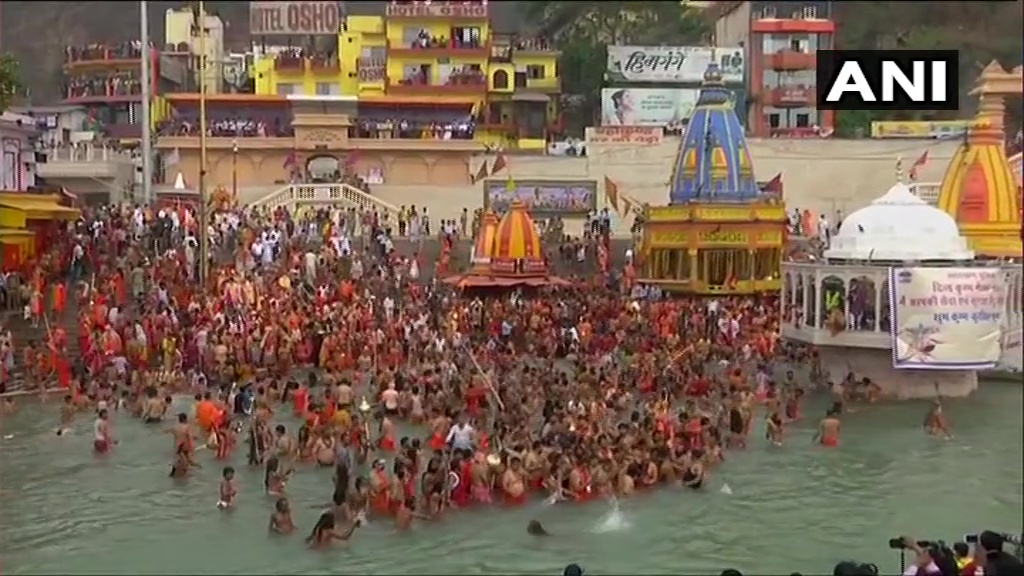
Haridwar Kumbh: COVID protocol in place, but fear of case spike looms large
A negative RT-PCR test and CCTV monitoring of people not wearing masks are the two methods the local administration at Haridwar have employed to keep COVID-19 at bay during the ongoing Kumbh Mela. Thousands of devotees, however, were seen taking a dip in the holy Ganges without wearing masks.

A negative RT-PCR test and CCTV monitoring of people not wearing masks are the two methods the local administration at Haridwar have employed to keep COVID-19 at bay during the ongoing Kumbh Mela. Thousands of devotees, however, were seen taking a dip in the holy Ganges without wearing masks.
The once-in-12-year-event began at Haridwar on April 1. The second Shahi Snan (holy bath) started on Monday (April 12).
The Health Ministry’s COVID-19 guidelines were clearly violated as more than one lakh devotees were seen by the river on Monday. Senior journalist Shekhar Gupta tweeted: “With 1.2 million active cases, and daily number reaching 2 lakhs, it’s bizarre to have poll rallies & a full Kumbh Mela. This will take the virus deeper into villages & small towns. This is the calamity we dodged with a crippling lockdown in 1st wave. Now we’re inviting it back.”
Also read: Haridwar Kumbh Mela will not be cancelled due to COVID, preparations on
Surprisingly, not many devotees think COVID-19 is a problem right now, because negative RT-PCR test is mandatory for every person who enters Haridwar.
Artificial Intelligence comes to the rescue
On its part, the local administration has installed over 350 CCTV cameras to monitor people moving around without masks. About 100 of the cameras have sensors that give an alert on capturing the image of a person without a mask. The Artificial Intelligence (AI) equipped cameras also send an alert to the police on locations vulnerable for stampede by mapping crowd density. Besides, the system is equipped to keep a count of vehicles at parking lots and point out objects lying unattended for more than 10 minutes.
The local administration, on its part, has effected traffic diversions. Besides, to avoid people’s rush to take a holy dip on Monday, a separate time slot has been allotted for seers of the 13 Akhadas, during which no devotees will be allowed to enter bathing sites.
”SOPs have been issued to the general public that will be applicable till April 30 which require public to submit negative RT-PCR report, a medical certificate and identity card to generate e-pass to be able to access Haridwar Kumbh area,” said IG SK Gunjyal, Mela Police officer, told NDTV.
Also read: Containing COVID at Haridwar Kumbh a daunting challenge
The big question, however, is that will all this help control a sudden blast in cases in the holy city of Haridwar? As of Sunday, 386 had tested positive in 24 hours. It took just a week for the cases to double up here. Haridwar has a total of 2,056 active COVID-19 cases.
Technology seems to helping. IG Gunjyal said that on April 2, over 1,500 people were ‘challaned’ for not wearing a mask, of whom around 350 were caught on camera in just four hours.
About Kumbh
Kumbh Mela, auspicious for Hindus, is one of the largest religious gatherings in the world. Besides lakhs of devotees, sadhus (seers) from 13 Akhadas will take a dip in the Ganges on Monday.
Held once in 12 years, this year’s Kumbh Mela comes with unique challenges with the second wave of COVID-19 raging across the country. Already, over 1.5 lakh COVID-19 cases being reported in the last 24 hours.
Night curfews on, but rush during day
Meanwhile, night curfew has been imposed at several places across the country, including Mumbai and Delhi.
All movements, except medical emergencies, were barred at night and public gatherings of more than five people are prohibited under night curfew, which stayed almost by the end of May last year after which phase-wise unlock began.
While the idea of night curfew is not new for people, mainly with the experience of the first lockdown last year, the question remains: Does it really help?
“Curfews, especially night curfews, are not expected to be helpful in curbing cases. The only purpose I can think they serve is to give a break to police and those in allied jobs, who are in charge of enforcing Covid-19 appropriate behaviour in the day,” professor Gautam Menon, departments of physics and biology at Ashoka University, told Quartz India.
Prof Menon’s argument sounds reasonable because while everything remains closed during night, people have been seen rushing to markets during the day, without caring much for COVID protocol. Heavy rush was seen at fish markets in Chennai and Bengaluru while people crowded old markets of Delhi.


